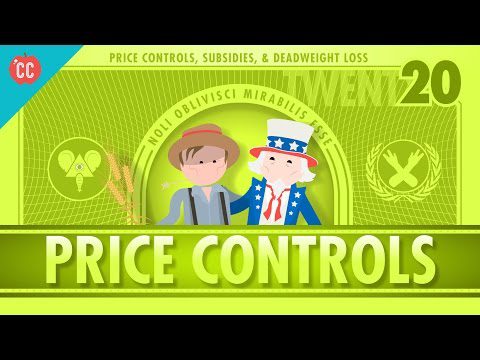Deci, în perioadele de inflație sau deflație, de ce guvernul nu stabilește doar prețurile? Sună rezonabil, dar plafoanele sau podelele de preț pur și simplu nu funcționează. Adriene și Jacob explică de ce. Subvențiile, însă, sunt puțin diferite și uneori chiar funcționează. Vom explica și asta. Astăzi veți învăța despre chestii precum controlul prețurilor, pierderea deadweight, subvenții și eficiență.
Crash Course este pe Patreon! Ne puteți susține direct înregistrându-vă la http://www.patreon.com/crashcourse
Mulțumim următorilor Patroni pentru contribuțiile lor lunare generoase care ajută la menținerea Crash Course gratuită pentru toată lumea pentru totdeauna:
Mark, Eric Kitchen, Jessica Wode, Jeffrey Thompson, Steve Marshall, Moritz Schmidt, Robert Kunz, Tim Curwick, Jason A Saslow, SR Foxley, Elliot Beter, Jacob Ash, Christian, Jan Schmid, Jirat, Christy Huddleston, Daniel Baulig, Chris Peters, Anna-Ester Volozh, Ian Dundore, Caleb Weeks
—
Doriți să găsiți Crash Course în altă parte pe internet?
Facebook – http://www.facebook.com/YouTubeCrashCourse
Twitter – http://www.twitter.com/TheCrashCourse
Tumblr – http://thecrashcourse.tumblr.com
Curs intensiv de asistență pe Patreon: http://patreon.com/crashcourse
CC Copii: http://www.youtube.com/crashcoursekids
Cursuri interesante:
- Inflația și bulele și lalelele: Curs intensiv de economie #7
- Curent electric: curs intensiv de fizică #28
- Eșecuri de piață, taxe și subvenții: Curs intensiv de economie #21
- Politica fiscală și stimularea: Curs intensiv de economie #8
- Emoție, stres și sănătate: curs intensiv de psihologie #26
- Economie de piață: Curs intensiv Guvernare și politică #46
- Homunculus: curs intensiv de psihologie #6
- Importuri, exporturi și rate de schimb: curs intensiv de economie #15
- Sistemul nervos, partea a 3-a – Sinapsele!: Curs intensiv Anatomie și fiziologie #10
- Introducere: Curs intensiv Guvernul și Politica SUA

Watching this 2022!! Amazing, I can gather so many current examples
So subsides are not given to private companies to pay off their debts with tax payers money????
It's easy to justify, cutting funding to 2% of the population. Agricultural subsidy help! Farms my net, more then a middle-class household, but what the farmer puts in his/her pocket, is often time below the poverty line.
I give this video a 9 or 10. Any socialist like to weigh in?
b r uh he called me handoms
Who else had to watch for class
5,22 Suomi mainittu torilla tavataan! The picture was from a Finnish market!
Didn’t work
Very dubious positions, fraudulent. No real references presented. Market fails always
Price Controls, Subsidies, and the Risks of Good Intentions: Crash Course Economics #20
Good intentions and how they can go wrong. Price controlscan derail markets. And subsidies can distort them.
1. Price controls
– In the early 1970s, Nixon established a 90-day price and wage freeze designed to fight inflation.
– 2 types of price controls:
+ Price ceiling: gov sets the maximum price of a specific good
Example: gas industry – when the gas prices fall, consumers wanna buy more, but producers will no longer find it profitable to sell gas, so lower price → shortate
+ Price floor: a law that sets a minimum price in a specific market
Example: corn production – higher price would give farmers an incentive to produce more, but, at that high price, consumers would go buy substitutes — things like wheat or rice. → farmers would not be better off and have fewer customers.
– In terms of actually helping consumers and producers, the vast majority of economists consider price controls counter-productive. But there is one notable exception: minimum wage.
– Many countries still use price ceilings: take Venezuela. In recent years they have been experiencing high inflation, so the government decided to impose price controls on consumer products like basic foods, medicine, and toilet paper. But, the new price is so low relative to the cost of production that farmers and factories can't make money. As a result, they've reduced or halted production of many goods, causing long lines, shortages, and empty shelves.
Now one argument for a price floor on corn is that if farmers can’t get a high enough price, they'll stop producing. Then we will run out of food and die.
2. Agricultural subsidies
– A subsidy is a government payment given to individuals or businesses. And they're often designed to offset costs to advance a specific public goal.
– Pros and cons:
+ Pros: prices for consumers fall, farmers get more money and the market remains at equilibrium. There Is no shortage or surplus. Proponents of farm subsidies say they can help provide a stable living to farmers, limit food price inflation, and make sure we grow enough food to feed everyone.
+ Cons: subsidies might discourage farmers from innovating and rethinking how they farm because they have guaranteed income from the government. If corn prices are down because demand has fallen, then it's inefficient and wasteful to spend money on subsidies. That said, if there is a drought or other natural disaster affecting farmers then some sort of short-term aid might be needed to keep farmers on their feet.
– Direct payments: government handed out checks to farmers based on land ownership and historical production levels. Farmers got them regardless of the market price for crops or how much they produced. In 2014, the government eliminated this system of direct payment subsidies. Instead, they help farmers with paying for crop insurance.
– Some argue that any form of government assistance distorts the market, resulting in unintended consequences. For one, it guarantees farmers an income, and perhaps encourages them to take more risks, like planting on less fertile land.
– What if there is something special about this product that buyers and sellers aren’t factoring in? In this case, the amount being produced is less than the amount society wants. The result would be deadweight loss. The inefficiency caused by the underproduction of this product. A subsidy would make society better off and improve efficiency.
I am indeed funny, smart and attractive.